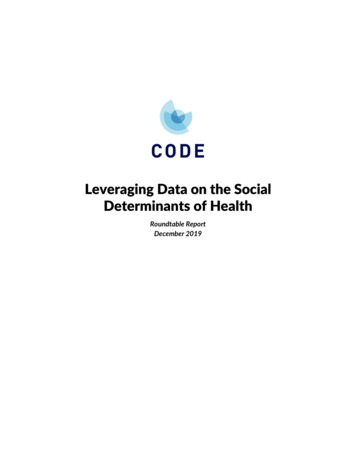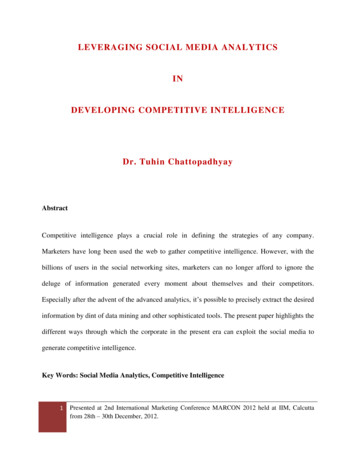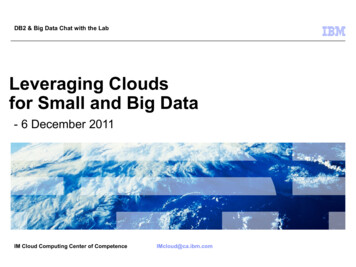
Transcription
Leveraging Data on the SocialDeterminants of HealthRoundtable ReportDecember 2019
Table of ContentsForeword by HHS Assistant Secretary for Health Admiral Brett Giroir2Executive Summary4Introduction5The Ecosystem of SDOH Data6Individual-Level SDOH Data6Population-Level SDOH Data6Overview of SDOH Data Categories7SDOH Projects and Initiatives9SDOH Data Stakeholders11Non-Government Stakeholders11Government SDOH Data Stakeholders15The SDOH Continuum of Care: Data Gaps and Successes18General SDOH Data Issues18The SDOH Care Continuum20Recommendations and Solutions26Define and Standardize SDOH Data26Create a Sustainable Infrastructure for SDOH Data28Support Local and State-based endices34High-Value Data Types for Health34Data Elements and Scenario Handout37Participating Organizations40Roundtable Agenda46References481
ForewordHHS Assistant Secretary for Health Admiral Brett GiroirAmerica yearns for a new approach to healthcare, and addressing the social determinants of health must be afoundational principle of that approach. America’s healthcare spending is unprecedented and unequalled,accounting for almost 18 percent of our Gross National Product (GNP), potentially topping 6 trillion by 2027.But sadly, we are not getting our money's worth for those expenditures - no matter how you look at the data.Of our 36 peer high-income OECD nations, the United States is 28th in life expectancy, and our life expectancydecreased even more in 2015 and 2017. If this trend continues, my two-year-old granddaughter will live ashorter life and with less quality than my generation. None of us believe that's acceptable.While sophisticated immunotherapies and genetic manipulations are always welcomed by those alreadysuffering, the key to our successes is much less esoteric – but equally challenging. Our nation must transformour “sick care system” into a “health promoting system.” And the key to that transformation is meaningfullyand sustainably addressing the social determinants of health. Social determinants impact every aspect ofdisease risk – nutrition, exercise, stress, and the environment; access to primary healthcare and earlydetection; and adequacy of treatment and recovery support. A few examples based on current HHS prioritiesare as follows:The drug overdose crisis. This is the most complex and daunting public health issue of our time, with almost70,000 Americans dying a year, often at the prime of their lives. The underlying factors are frequently foundin social determinants, including unemployment and lack of economic opportunity; housing insecurity; arduouslabor that predisposes to traumatic injury and chronic pain; lack of access to treatment or alternatives; andthe significant impact, especially on risk of methamphetamine abuse, of adverse childhood experiences,including sexual or physical abuse.Infant mortality. A recent study by researchers at the National Center for Health Statistics documented thehigh rate of infant mortality in the poorest regions of our country, the Mississippi Delta and Appalachia.iObesity, teenage pregnancy, smoking, and malnutrition all contribute to infant mortality in these areas. Wewill never solve infant mortality or maternal mortality if we don't work on these socially related problems.The obesity epidemic. A 2017 study of trends among today’s two-year-olds projected that nearly 60 percentof them will be clinically obese by the time they’re 35.ii We’re already seeing that three-quarters of our 17to-24 year-olds would not qualify for the military if they tried to join, many of them because of obesity. Forobesity, social determinants are everywhere: food deserts and food insecurity; lack of access to safe sidewalksand parks; lack of affordable youth sports; and lack of access to preventative and treatment services. Frommy former work in Texas, in the border counties, people generally knew what they should eat and how theyshould change their lifestyle, but were prevented from doing so by social, economic, and demographicroadblocks.iThakrar, Ashish P., Alexandra D. Forrest, Mitchell G. Maltenfort, and Christopher B. Forrest. “Child Mortality In The USAnd 19 OECD Comparator Nations: A 50-Year Time-Trend Analysis.” Health Affairs 37, no. 1 (January 2018): .iiScienceDaily. “More than Half of US Children Will Have Obesity as Adults If Current Trends Continue.” AccessedNovember 25, 2019. 30085733.htm.2
Dementia. Social engagement and cognitive activities can decrease the risk of Alzheimer’s and other diseases,but isolation and loneliness are rampant in our society. Together with proper nutrition and exercise –themselves dependent on social determinants – we have a real opportunity to impact the upcoming “silvertsunami.”HIV/AIDS. Despite the “medical miracle” of modern anti-retroviral therapy and pre-exposure prophylaxis,there are still approximately 40,000 new HIV cases a year in America. We believe, and programs such as RyanWhite have proven, that the social determinants are inexorably linked to new infections – beginning withsocial stigma preventing early diagnosis and linkage to care. But even then, lack of transportation, housing,adequate food, or a home, the expense and time associated with getting medical therapy, often keepstreatment out of reach.Truly, in America, your ZIP code is still more important than your genetic code. And as a society, we must“change the map” and finally address health disparities stagnant for generations. While the emphasis on accessto clinical care and the quality of that care is important, they account for only about 20 percent of healthoutcomes. Everything else is wrapped up in air and water, housing and transit, faith, family and social support,community and safety. We will never solve our healthcare spending addiction, or our progressive degradationof health, unless we focus on what causes 80 percent of the poor health outcomes in this country.Value-based care means meeting patients where they are, and freeing up doctors and nurses and pharmacistsand health systems to attack the core of the problem. That could translate into temporary housing, ortransportation, or medically tailored meals. Or it could be an exercise coach, or sponsored farmers’ markets,or just extra love and attention by a visiting paraprofessional. Value-based transformation means that socialdeterminants are no longer an afterthought, but for many people are truly the “main event.”Our office emphasized in Healthy People 2020 that the social determinants are an essential ingredient for ahealthful nation. But we can only focus on social determinants that we can reliably and accurately measure –so much foundational work still needs to be accomplished. As we begin work on Healthy People 2030, wehave reliable data on employment, college enrollment, poverty, and housing insecurity, among other indicators.We need more indicators, and ones which more closely correlate with the health outcomes we desire; by2025, it is my hope that we have new levers to pull, and more tools in our social determinants toolbox.Our office is dedicated to catalyzing a health-promoting culture, moving people from treatment towardsprevention, with a focus on integrating social determinants into sustainable healthcare systems and platforms.And by doing that, we will decrease costs, and increase longevity and quality of life – not for some, or most,but all.Admiral Brett GiroirAssistant Secretary for HealthU.S. Department of Health and Human Services3
Executive SummaryThe independent nonprofit Center for Open Data Enterprise (CODE) and the Office of the Chief TechnologyOfficer (CTO) at the U.S. Department of Health and Human Services (HHS) have co-hosted a series of threeRoundtables to find ways to improve how health data is shared and utilized for the public good.As the third event in this series, CODE and the HHS Office of the CTO convened a Roundtable on LeveragingData on the Social Determinants of Health. The social determinants of health (SDOH) are defined as the“conditions in which people are born, grow, live, work and age that shape health.”1 This Roundtable broughttogether about 80 expert stakeholders from industry, academia, federal, state and local government,healthcare, and civil society to help HHS catalyze the use of SDOH data to improve health outcomes.Participants discussed current SDOH data use cases, reviewed high-priority data elements and scenarios, andshared actionable opportunities for HHS to support individual-level and population-level approaches toaddressing the social determinants of health.This report, written by CODE, includes a number of recommendations from CODE based on the input ofRoundtable participants and CODE’s additional research. (These recommendations do not represent aconsensus of Roundtable attendees, and do not represent the views of HHS or any other government agency.)CODE’s overall recommendation is that HHS develop an SDOH data strategy that comprehensively maps thespace and helps coordinate action among different stakeholders. That strategy can include action plans toachieve three critical goals: Define and Standardize SDOH Data. This can include improving and aligning open-sourceassessment tools, adopting data standards and definitions, and developing a data governance body.Create a Sustainable SDOH Data Infrastructure. This can include improving financial alignment forpayers, providers, and community-based organizations (CBOs) and strengthening CBO data capacity.Support Local and State-based Decision-makers. This can include developing hyper-local snapshotsof communities and creating state-level SDOH strategy toolkits.This Report summarizes the findings of the Roundtable in the following sections:Introduction: An overview of the Roundtable’s purpose, format, and major findings of the Roundtable.SDOH Data Landscape and User Ecosystem: This section describes high-priority SDOH data, keystakeholders for the data, the decisions they seek to make, and high-value examples of how they areusing SDOH data.Addressing SDOH Data Along the Care Continuum: This section describes what’s working and whatcan be improved to increase the proper and effective use of SDOH data along the care continuum.Actionable Opportunities: Based on the challenges identified in the Roundtable, this section describeshigh-priority opportunities for HHS to leverage SDOH data and presents CODE’s recommendations.Conclusion: The report concludes with perspective from Dr. Karen DeSalvo, the former AssistantSecretary for Health and Co-Convener of the National Alliance to Impact the Social Determinants ofHealth.4
IntroductionHealth disparities in the United States are often related to factors that exist outside the four walls of thedoctor’s office. The social determinants of health (SDOH) represent a growing area of focus in the healthcareindustry, and a major tool for addressing healthcare inequalities. SDOH are defined as the “conditions in whichpeople are born, grow, live, work and age that shape health.”2 Doctors and researchers increasingly recognizehow profoundly SDOH data can influence health risks and treatment outcomes. As some experts have put it,a person’s ZIP Code can be at least as important as his or her genetic code in predicting health risks.Health-focused organizations across the private sector and civil society are now realizing the potential ofSDOH data. Healthcare providers and payers are using the data to better understand and address theirpatients’ needs. Health management companies are applying the social determinants of health to predicthealth risks like opioid overdose and target preventive interventions. Other companies are serving as SDOHdata providers, creating platforms of SDOH data for research and healthcare applications. Civil society groupsare serving as conveners for a variety of stakeholders and seeking to increase coordination to improve patientcare. They are demonstrating how SDOH data can provide a holistic understanding of factors that affect anindividual’s risk of disease and response to treatment, including measures as diverse as the air quality of aperson’s neighborhood or their proximity to a grocery store.The Roundtable on Leveraging Data on the Social Determinants of Health brought together health and dataexperts from HHS, other federal and state government agencies, industry, healthcare provider organizations,and patient-advocacy groups to identify ways to realize the power of SDOH data. Opening remarks fromMona Siddiqui, Chief Data Officer in the HHS Office of the Chief Technology Officer (CTO), and HHS CTOEd Simcox underscored the Department’s commitment to harnessing data on social determinants of health totackle health and social problems.The Roundtable then featured lightning talks on innovative applications of data to address the socialdeterminants of health. Speakers from Humana, the Mount Sinai Health System, the Robert Wood JohnsonFoundation, Unite Us, and Lyft all highlighted unique uses of SDOH data to address comprehensive needs ofthe populations they serve. Many of the use cases from these lightning talks are described in this report.Throughout the day, participants engaged in a series of discussions and facilitated breakout sessions thatcovered a wide variety of topics. The day kicked off with a discussion on SDOH use cases and opportunitiesand led into an afternoon session on identifying and prioritizing data elements for HHS’s SDOH strategy.Additional breakout sessions focused on challenges and actionable opportunities for individual and populationlevel SDOH data.As policymakers work to apply SDOH data, this report can contribute to the conversation in two ways. First,it provides a user-focused view of SDOH data by describing several innovative examples and the policy andhealthcare issues they address. Second, this report describes the challenges of applying SDOH data along thecontinuum of care and ways that the use of this data use can be improved. This Report, written by the staffof CODE, summarizes insights and recommendations from individual Roundtable participants as well as expertinput before and after the Roundtable. It is not meant to represent a consensus of the participants, and doesnot represent the views and opinions of HHS or its leadership or staff. CODE hopes this report will be ofvalue to all stakeholders, inside and outside of government, as they address these important issues.5
The Ecosystem of SDOH DataIn today’s healthcare sector, clinicians, researchers, and policymakers recognize that conditions outside of thedoctor’s office have a disproportionate impact on a patient’s health. While a person may spend 15 minutes ina doctor’s office, they reside in communities with varying levels of access to nutritious food, safe housing,reliable transportation, and other critical needs. The rise of interest in the social determinants of health hasbeen complemented by increasing access to health data. Healthcare companies are relying on growingamounts of consumer-generated, genomic, and survey-based public health data to produce moresophisticated algorithms to model patient risk profiles.3 The same kinds of data can be used to develop publichealth strategies, support health research, and target social services. This data can be produced by thegovernment, collected by the private sector, gathered from consumers, or aggregated and shared throughthird parties like research and civil society organizations. This section describes the distinction betweenindividual and population-level data, the primary categories of social determinants of health, and the work thatHHS is carrying out to prioritize high-level SDOH data. In this report, CODE has used the following definitionsof these key terms: Social Determinants of Health: The conditions in which people are born, grow, work, live, and age,and the wider set of forces and systems that shape the conditions of daily life. These conditionsimpact everyone, and may have either positive or negative effects. Social Needs: An individual’s immediate non-medical needs such as food, housing, or transportation. Social Risk Factors: Specific adverse social conditions that are associated with poor outcomes. Theserisk factors are distinct from social needs since a person may have social risk factors, such as foodinsecurity or housing instability, but may not have immediate needs for food, housing, or otheressentials. Social risk factors can also include factors like high crime or lack of recreational facilitiesthat impact the community as a whole and its residents’ health.Individual-Level SDOH DataA large amount of SDOH data is collected directly from individuals and is captured in their health records,where it can be analyzed. Medicaid recipients, for example, may have individual-level data collected by theirphysicians or through clinical trials. This data may be collected through health networks, schools, andCommunity-based Organizations (CBOs). Individual-level data is often the focus for the Centers for Medicare& Medicaid Services (CMS), the Gravity Project launched by the Social Interventions Research and EvaluationNetwork (SIREN), and other initiatives that are improving precision medicine. While this data can be extremelyuseful in tailoring interventions for the individual, much work remains to be done to standardize data elements,data collection, and data sharing, as well as resolve important ethical issues identified below. Better systemsare needed to enable consumers to give permission for their data to be used before it can be widely applied.Population-Level SDOH DataMany federal, state, and local government agencies and civil society organizations openly publish SDOH dataon factors such as income, education, and other factors at the community level. This data may be available atthe county, city, ZIP Code, or Census tract level, and can be analyzed together with individual-level healthdata to better predict individual and population risk. Population-level SDOH data can come both from HHSand from other federal agencies such as the Census Bureau, the Department of Labor, the Department ofTransportation, and the Department of Education. This data is increasingly generated at the local level and6
can be aggregated by private sector companies, researchers, and nonprofits to create visualizations that helpunderstand risk and prioritize underserved communities.Overview of SDOH Data CategoriesMany national groups are working to define categories of SDOH data. Among these, the Kaiser FamilyFoundation has produced an accessible and widely used framework to describe the high-level categories ofSDOH data. (The Gravity Project and Healthy People 2020, described below, also provide importantframeworks.) The Kaiser Family Foundation matrix, shown in the table below, provides an excellent startingpoint for reviewing key categories behind the social determinants of health. This section describes some ofthe important factors in the first four of these categories: economic stability, neighborhood and physicalenvironment, education, and food. These categories may draw on important data sources that are notrestricted to health and healthcare institutions. The fifth category, community and social context, appears tohave fewer data sources readily available, and data on the sixth category, healthcare system, is found withinhealth and healthcare organizations.Figure 1: Kaiser Family Foundations Social Determinants of Health4Economic Stability: A person's ability to pay bills on time, create longer term budgets, and stay out of debtare functions of their economic stability. More at-risk communities may experience challenges due to parttime work at low-paying jobs, a lack of access to stable financial institutions, and financial hurdles in payingfor insurance to protect their assets. The literature on unemployment, for example, has repeatedlydemonstrated that long-term unemployment has adverse health outcomes.57
Neighborhood and Physical Environment: Even when patients have access to healthcare, they may facechallenges in getting to and from their doctors’ offices. Moreover, they may not feel comfortable leaving theirhomes due to safety issues or may lack access to public green spaces. A person's neighborhood may alsoimpact his or her health outcomes because of subpar housing, the threat of crime, environmental hazards, andpoor walkability. A body of evidence has emerged that a person’s neighborhood directly impacts the amountof walking and cycling they can do, which impacts overall health.6Education: People who have limited educational opportunities or attend poor schools may fall behind andgenerally receive less support as they progress through the system. These educational disadvantages canimpact an individual’s health literacy by limiting comprehension of important clinical recommendations ormaking it difficult to understand diagnoses. They also may lead to poorer economic outcomes as individualsmust accept low-wage positions or work in environments with higher risk factors. A 2013 Report notes thatthe mortality rate for white women who have not completed high school is four times higher than it is forwhite women with 16 or more years of education.7Food: Access to healthy foods and subsidy programs like SNAP and WIC are indicators that can provideimportant insights into nutrition and health. Individuals who consume high amounts of fatty or sugary foodsare more likely to develop obesity, hypertension, and other chronic conditions. In addition, the literature hasdemonstrated that cheaper foods often have fewer nutrients, causing more micronutrient deficiencies andimpacting obesity.8 Moreover, children with poor access to nutritious foods or milk may face developmentalchallenges from poor nutrition.Climate and Environment Data. This category is a suggested addition to the categories in the Kaiser matrix.While SDOH data within a neighborhood is important, additional factors that are not confined toneighborhood borders also have a major impact on an individual’s health. These include climate, weather, andair and water quality.Figure 2: Social Determinants Categories and Sample Public Data SourcesCategorySample DeterminantsSample Public Data SourceEconomic Stability Access to employmentHourly wagesLevel of personal debt HousingAccess to transportationPublic parksSafetyGeneral geography Literacy ratesVocational training opportunitiesEarly childhood educationRates of higher education Neighborhood andPhysical EnvironmentEducation 8 Department of LaborUnemployment StatisticsInternal Revenue Service IncomeTax RatesZillow’s walkability and homeownership ratesDOT’s data on proximity topublic transportationNational Parks Service data onparks and recreational areasDepartment of Education highschool dropout ratesHead Start early childhoodeducation enrollment figures
Food Climate andEnvironmental Data Access to fresh fruits and vegetablesNumber of grocery stores in aneighborhoodNumber of residents who accessfood pantries Air and water qualityAccess to clean waterExposure to power plant emissions WIC and SNAP rates byneighborhoodiiiProximity to a grocery storeAccess to a food pantry or otheremergency food serviceU.S. Environmental ProtectionAgency (EPA) air quality andtoxic waste dataU.S. Department of Energy(DOE) data on power plants.SDOH Projects and InitiativesThere are several nationwide initiatives that seek to better categorize data elements and produce acomprehensive information repository. Healthy People 2020, led by HHS, has sought to promote a sharedunderstanding of the social determinants of health. Additional projects have been led by civil society, such asthe Gravity Project and the National Alliance to Impact the Social Determinants of Health, which have helpedbuild multi-sectoral collaboration around data standards and the value of addressing social needs.Healthy People 2020. Healthy People 2020 provides a broad-based strategy for health promotion anddisease prevention based on a wide range of stakeholder feedback. It is also the primary framework that theU.S. federal government uses to promote and leverage data on SDOH. Healthy People 2020 uses a placebased organizing framework to address SDOH. This framework focuses on five areas and is designed toidentify ways to create social and physical environments that promote good health for all.9 Healthy People2020 defines the SDOH as the conditions in the environments in which people are born, live, learn, work,play, worship, and age that affect a wide range of health, functioning, and quality-of-life outcomes and risks.HHS is currently developing a Healthy People 2030 initiative to build on this work.The Gravity Project: Establishing SDOH Data Standards. The Gravity Project is a public multi-stakeholderinitiative that is seeking to standardize key data elements necessary for documenting clinical and otheractivities related to the social determinants of health, in order to improve interoperability, exchange, and useof SDOH data across the health and human services sectors.10 Started by the Social Interventions Research& Evaluation Network (SIREN) at the University of California, San Francisco, the Gravity Project convenes abroad range of public and private stakeholders including healthcare providers, payers, civil society,government, and others, and has focused its work initially on transportation, food insecurity, and housinginstability and quality. The consensus-based project will study use cases to identify common data elementsand set guidelines compatible with the Fast Health Interoperability Resources (FHIR) Specification, anemerging standard for exchanging healthcare information electronically. The Gravity Project will also articulatea set of standard data elements and recommended medical codes needed for faster data exchange and wideruse in clinical settings.iiiWIC stands for “The Special Supplemental Nutrition Program for Women, Infants, and Children” and SNAP stands forSupplemental Nutrition Assistance Program.9
National Alliance to Impact the Social Determinants of Health (NASDOH). NASDOH is a cross-collaborativegroup of stakeholders that is seeking to build a common understanding around the importance of addressingthe social determinants of health.11 The Alliance brings together this wide range of policymakers, healthcarepractitioners, civil society members, and technology companies to identify best practices in emergingapplications of the social determinants. These best practices often feature case studies by sector, and alsodemonstrates the value that technology can play in enhancing the use of the social determinants of health.Moreover, NASDOH provides a suite of resources and tools for groups hoping to leverage new technologies,screening assessments, and data metrics to better evaluate patients for their social needs.10
SDOH Data StakeholdersIndividual and population-level data on the environmental and social contexts of health forms the foundationof SDOH, and stakeholders leverage this data to improve patient care, increase the ecosystem of availableinformation, and improve preventive strategies. The ecosystem of SDOH data providers and users iscomprised of both non-governmental and government stakeholders. These stakeholders utilize and contributeto the SDOH data ecosystem in a variety of ways that are outlined below.Throughout this section and those that follow, we have included a number of examples in boxes, taken fromtalks at the Roundtable and other sources, that show how SDOH data is now being applied.Non-Government StakeholdersThe private sector, healthcare groups, and civil society have developed different initiatives and approaches tocollect, analyze, and use SDOH data at the local level.Civil Society Alliances and GroupsCivil society groups develop local coalitions, task forces, and working groups to better share data and provideresources to their clients. Groups like Aligning for Health are diverse coalitions of stakeholders that focus onimproving coordination of care or increasing the use of SDOH data to advance research on treatment andoutcomes. Other civil society groups, like the Urban Institute and Kaiser Family Foundation, publish researchdriven white papers and host conferences like the Next50 Changemaker Forum. These groups serve assupport systems for larger data-sharing coalitions and provide research and recommendations to improveSDOH data sharing and usage. They develop advocacy strategies and identify underserved demographicgroups. The Alliance for Better Health, for example, is a diverse coalition of stakeholders who work acrossmedical and community sectors to address the health needs of Medicaid members and uninsured individuals,and relies on a combination of data from different providers. Other groups like the National Alliance to impactthe Social Determinants of Health (NASDOH) aim to build multi-sectoral coalitions to articulate the value ofaddressing the social determinants of health.Robert Wood Johnson Foundation’s City Dashboards and IndicatorsThe Robert Wood Johnson Foundation (RWJF) has been a strong proponent of increased action on thesocial determinants of health and helped develop the Culture of Health Action framework to improve overallpopulation health. This framework seeks to make a culture of health a shared value, increase collaborationacross sectors, and strengthen the integration of health services and systems. RWJF has chosen to build onthe work of the county health rankings to more granular approaches to SDOH data through cities and smallarea estimates. These metrics can allow researchers to compare major indicators like food access, housingcosts, violent crime, walkability, and other metrics across cities. RWJF has now partnered with
White have proven, that the social determinants are inexorably linked to new infections - beginning with social stigma preventing early diagnosis and linkage to care. But even then, lack of transportation, housing, adequate food, or a home, the expense and time associated with getting medical therapy, often keeps treatment out of reach.











